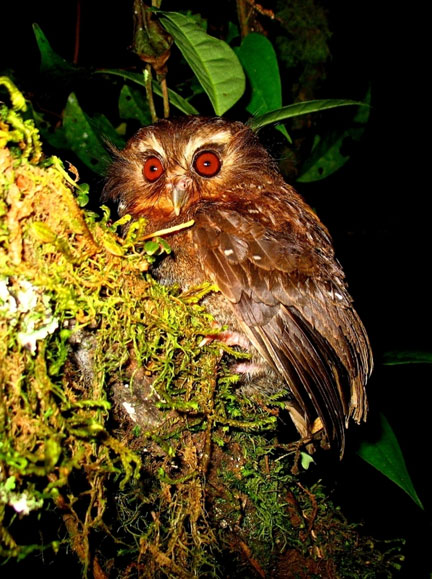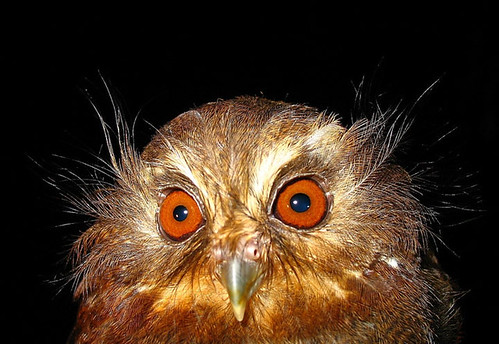tags: Long-whiskered Owlet, Xenoglaux loweryi, birds, birding, ornithology
The strange and extremely rare Long-whiskered Owlet, Xenoglaux loweryi, has been seen in the wild for the first time on a private conservation area in Northern Peru by researchers. The bird, a species that wasn't even discovered until 1976, and until now was only known from a few specimens captured in nets after dark, was seen in the Area de Conservación Privada de Abra Patricia -- Alto Nieva. This sighting is considered a holy grail of South American ornithology and has not been accomplished in thirty years, despite the efforts of hundreds of birders.
The species is among the world's smallest owls. It is so distinct that it has been named in its own genus: Xenoglaux, meaning "strange owl" on account of the long wispy feathers or whiskers that stream out from its wild-looking reddish-orange eyes. The owl inhabits the dense undergrowth of mountain forests in a remote part of northern Peru.
"Seeing the Long-whiskered Owlet is a huge thrill," said David Geale of Asociación Ecosistemas Andinos (ECOAN) who was part of the research team. "Its population is estimated to be less than 1,000 birds, and possibly as few as 250. Due to the rapid destruction of its forest habitat and its tiny range, it is inferred that the species is in serious decline. Until recently, the owlet's key habitat was completely unprotected."
The Long-whiskered Owlet has previously been captured by researchers on at least three occasions, but until 2002 nothing was known of the bird's natural history. At that point, calls were recorded from a captive bird, but its biology still remained virtually unknown. Last month, researchers Geale and Juvenal Ccahuana, rangers of Abra Patricia and monitors of the MNBCA program from Alto Mayo, encountered the owlet three times during daylight hours and recorded its calls frequently at night. Several photographs were also taken of a bird captured in a mist-net and later released onto a tree branch where it posed for photographs before disappearing into the night.
"The creation of the Area de Conservación Privada de Abra Patricia -- Alto Nieva, located in the Northern end of the Peruvian Yungas ecosystem, provides protection for the key site for the Long-whiskered Owlet," said Hugo Arnal, American Bird Conservancy's (ABC) Tropical Andes Program Director. "By establishing a reserve and protecting the owlet's forest habitat, ABC and its partner ECOAN are giving many other species a chance to survive as well."
The northeastern section of the Peruvian Yungas, comprises habitat for 317 resident bird species, of which 23 are considered globally threatened. The conservation area also protects much of the known habitat for the endangered Ochre-fronted Antpitta, and has been declared a priority by the Alliance for Zero Extinction. Other endemics in the area include the endangered Royal Sunangel (a hummingbird), the rare and recently-described Johnson's Tody-Tyrant, and the endangered Ash-throated Antwren.
Several songbirds that breed in North America such as the beautiful Blackburnian Warbler also use these forests during the winter. Other migratory species include the Broad-winged Hawk, Swainson's Hawk, Swainson's Thrush, and Alder Flycatcher. In total, 29 neotropical migrant species use this area, of which 13 are of conservation concern. Nearly 98% of the reserve consists of well-preserved stands of typical Yungas forests, and it is also considered a rich area for orchids.
ABC's work in the region is supported by the Gordon and Betty Moore Foundation, Conoco Phillips, the National Fish and Wildlife Foundation, and Robert Wilson. Birdwatchers wishing to search for the owl should contact Hugo Arnal at American Bird Conservancy. Access is strictly limited to small groups and the chances of success though better than in the past are still considered very low for anything but the luckiest groups.
Source: emailed press release.
Images: All photos by Asociación Ecosistemas Andinos (ECOAN).




What a beautiful little bird.
CUTE! I want an owlet to sit on my hand like that. :)
Much as I hate to admit to this, that second pic made me think
O RLY?
I wonder what the owl in the first photo is doing behind that branch.
Bob
Owl appears to watch too much tv.
I look at that owl, or ANYTHING in nature, & think: God is sooooooo awesome!
Do you feel the same when you read about the Guinea Worm ?
Carel van Kempen already has a painting of it!
Strange Owlet
for some reason i'm put off by the LAST photo, which shows a human holding it in its hand - chances are a wild animal won't let you do that without some sort of coercion... wonder what they did to obtain that.